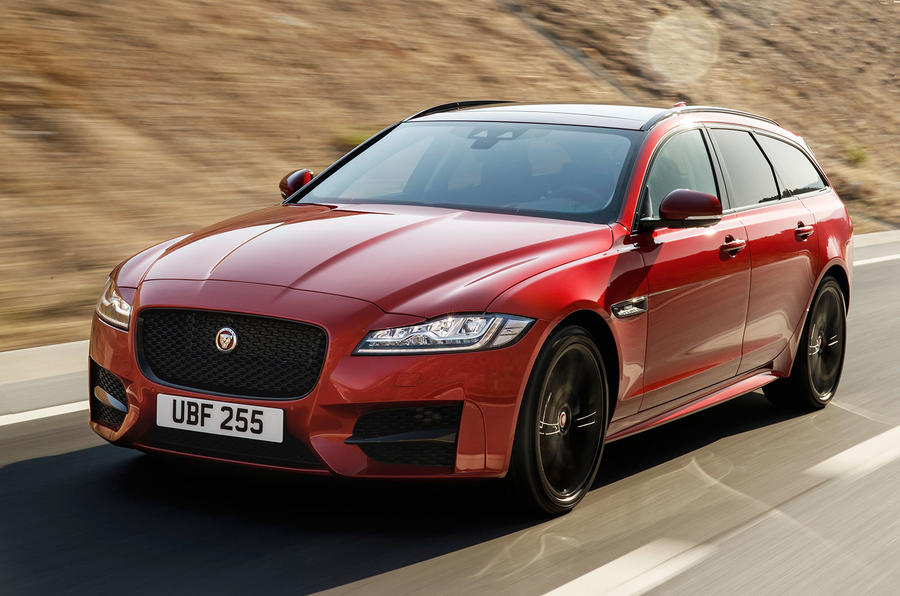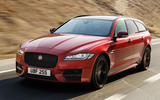What is it?
Choosing a petrol version of the new XF Sportbrake means choosing Jaguar’s familiar 2.0-litre Ingenium turbocharged four-pot, presented in 247bhp tune (unlike the saloon, the load-lugger’s S variant comes exclusively with diesel power). It also means the equally familiar eight-speed ZF auto ’box and rear-wheel drive.
Although we’re testing it in aesthetically bolder R-Sport guise (which carries supplements of £2400 and 70kg versus its saloon counterpart), all Sportbrake variants come with firmed-up sports suspension, while adaptive damping is an £820 option that our car foregoes. As well as styling accents inside and out, the R-Sport also gets front parking sensors to supplement entry-level kit that includes heated, eight-way electrically adjustable leather front seats, rear parking sensors and an 8.0in touchscreen, as well as niceties such as roof rails, self-levelling rear air springs and power tailgate.
The Sportbrake fulfills the practicality part of its remit well, closely matching the BMW 5 Series Touring and Audi A6 Avant for boot volume at 565 litres with its 40/20/40 split-folding rear seats up and 1700 litres when they’re folded flat. The load space is usefully regular, with an electric load cover, curry hooks and no lower lip. Cabin space impresses, too, with ample room for four large adults plus a halfling, and sufficient nooks in which to stow your daily detritus.
What's it like?
Materials in the smartly presented interior range from tidily stitched dashboard leather to both soft and hard plastics – although I wouldn’t choose the optional veneer, which has an odd, embalmed finish to it. Switchgear doesn’t feel quite as robust as that of rivals, but while the optionally upgraded infotainment could do with a manual controller to supplement its 10.2in touchscreen, it has lots of features and is pleasingly responsive. The sports seats are comfortable but not especially well sculpted among their type.
The petrol Ingenium is less of a workhorse than the 237bhp diesel version, giving away 99lb ft of torque and 100kg of towing ability to the oil-burner. But its refinement is far superior, emitting a gentle hum whose heightened pitch and volume as revs rise is barely noticeable once on the open road. Either dawdling in town or sitting at 2000rpm at 70mph, it’s both enjoyably hushed and unobtrusively managed by the gearbox, although downshifts can feel a bit lazy even in the toque converter’s most responsive setting.
Turbo lag is almost as gentle, but that’s partly because 247bhp doesn’t seem enough to make the 1705kg petrol Sportbrake feel that fast anyway. At 6.7sec, it’s 0.4sec slower to 60mph than the equivalent saloon, and although power delivery is steady all the way from 2500rpm to 6000rpm, it’s never especially keen, while Dynamic mode, which also firms the tiller and heightens gearbox mapping, makes the throttle a tad bitey.
Deeper potholes brought a thud from the optional 19in alloys, but otherwise the Sportbrake rides well and flows neatly over undulations taken at speed. Neither body control nor rear-end traction is much challenged when driving this car within the constraints of its modest powertrain, but the responsive front end and natural-feeling steering help make it an enjoyable thing to sweep along backroads. The helm gives decent feedback, too, but could be more settled at a cruise.































Join the debate
Add your comment
Twenty years ago...
...this kind of power would have been considered ludicrous.
And the roads were way less crowded as nowadays.
BeamMeUpScotty wrote:
I thought the same. When I started driving, the Ferrari 308s and Lamborghini Urracos of this world were generating similar 0-60 times. A 5.3 litre Jaguar V12 was probably a second slower, and all three were in the teens for mpg. That you can blow those cars into the weeds with a 2 litre, 4 pot, 5 seater estate and return 40mpg is pretty amazing.
Also
The estate misses of on either 4wd or the Petrol 4cyl 300 ps engine potentially the pick of the range
Not enough?
0-60 in 6.7 s. Not enough? I know Jags are meant to be fast, but how fast do you need to go? I must say that, to minimize emisssions, the throttle response on all modern cars seems to be damped. Once you get going there's usually way more power than you need, but pulling out at junctions, you just want some power NOW.